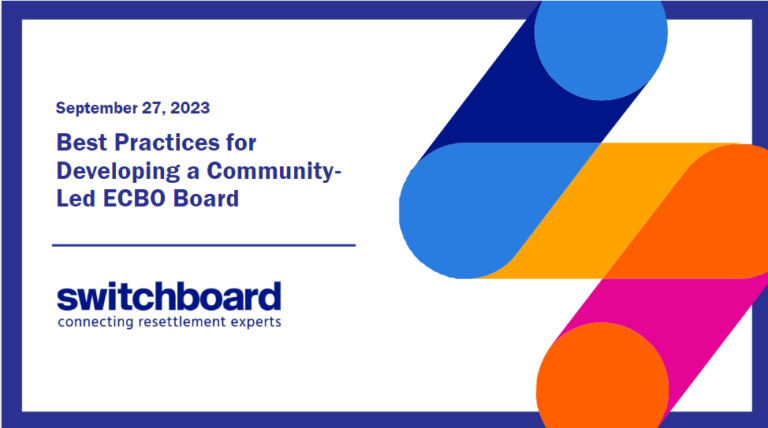A community advisory board (CAB) is a group of individuals from a specific community who come together to provide guidance, feedback, and support to organizations, projects, or initiatives impacting their community. CABs are often useful in health care, education, research, and community development projects to ensure that the voices of community members are heard and considered in decision-making processes. This blog offers guidance on how to develop a CAB, structure CAB meetings, recruit participants, and address common challenges.
Defining the Purpose of the CAB
When developing a CAB, it is important that CAB participants actively lead—alongside your organization—in defining the goals of the program and cultivating support for its development. Below are some factors to consider when deciding on the purpose of the CAB and presenting the CAB concept to the community:
- Alignment with community needs: Identify key issues and priorities through listening sessions with trusted community leaders.
- Clarity on the CAB’s role: Define how exactly CAB members will advise on and influence decision-making.
- Clear objectives: Establish realistic, measurable goals (e.g., improving services, increasing engagement).
- Communication planning: Be able to clearly explain the purpose of and time commitment required for the CAB so that potential participants are well informed about what they are signing up for; this explanation should make sense to the broader community and its various stakeholders.
Example Discussion Topics for CABs
Below are examples of typical discussion topics that help CABs fulfill their purpose:
- Feedback: e.g., how effective was the mobile health clinic in reaching homeless populations in the downtown area? What barriers prevented people from accessing the mental health services offered?
- Considerations: e.g., what cultural protocols should our research team follow when collecting health data from indigenous community members? Which community leaders should we consult before launching the diabetes prevention program?
- Identification of community needs: e.g., which neighborhoods lack access to fresh produce and would benefit most from a community garden program? What transportation solutions would help elderly residents attend health appointments? How can we improve safety in local parks to encourage physical activity?
Recruiting CAB Members
Recruitment Tips
- Identify potential members through existing relationships and community networks.
- Work with a community liaison who is well-connected and skilled in relationship building to identify potential CAB members.
- Hire a community liaison with relevant ties to the community.
- Attend community events and personally invite interested and qualified individuals.
- Prioritize trust-building and long-term engagement from the start of any project.
Composition of a CAB
- CABs should ideally include 10 to 16 members for effective discussion and representation.
- CAB membership should represent varied perspectives within the community.
- If working with both youth and adults, consider separate CABs for each group.
- Youth CABs are especially valuable for projects addressing children, teens, and family system issues, all of which benefit from youth perspectives.
Qualifications for CAB Members
Make sure to establish clear selection criteria and guidelines before recruiting members. Consider whether these criteria make sense given the cultural backgrounds of the clients you serve—how you define skills in one culture may not be as relevant in another culture!
Generally speaking, CAB members should:
- Foster strong relationships with the community.
- Share meaningful experience with the population served.
- Possess strong interpersonal skills and comfort in group discussions.
- Understand the dynamics that may impact participation.
- Possess genuine interest in the CAB and be able to commit sufficient time.
CAB Meeting Structure and Coordination
Efficient coordination and organization are crucial for a successful CAB meeting. This can be accomplished through the following methods:
- Designate a CAB coordinator as the main point of contact for communication. This person can help communicate with community members about CAB logistics and coordinate with other staff in the planning process.
- Structure meetings to maximize participation and engagement. Come to the CAB meetings with a flexible, open agenda that all participants can contribute to.
- Schedule meetings at a frequency and in a format (virtual, in-person, hybrid, alternating) that aligns with project needs and member availability.
Common Challenges and Solutions
Limited Engagement
It can be challenging to bring together groups of people given the demands of everyday life—and even more challenging to hold their attention. Below are some ideas for how to promote effective engagement from CAB members.
- Acknowledge the active role that CAB members can have in shaping projects and foster a trusting environment where members feel their voices are centered and valued.
- Incorporate engaging and interactive activities during the meetings to keep members interested and involved.
- For leaders of CAB meetings: practice responsive facilitation to make sure that no member’s voice is suppressed.
Lack of Meaningful Collaboration
Organizers and leaders in the CAB should always remember the purpose and goals set forth. Below are some points of advice on how to maintain meaningful collaboration.
- Service providers and researchers must genuinely integrate CAB feedback into decision-making.
- Ensure that community members with varying perspectives are represented in the meetings.
- Maintain communication throughout a project or program’s implementation to show how CAB decision-making has positively affected programmatic changes.
Challenges to Participation
Address logistical challenges in the following ways:
- Acknowledge the time, effort, and expertise CAB members give to your organization by providing incentives such as travel reimbursement, food, and child care during meetings. By addressing common barriers to attendance, these measures can also make participation more accessible.
- Be flexible in planning and scheduling meetings and stay mindful of religious days and holidays.
- Identify a meeting space accessible to all participants which can accommodate meeting activities.










